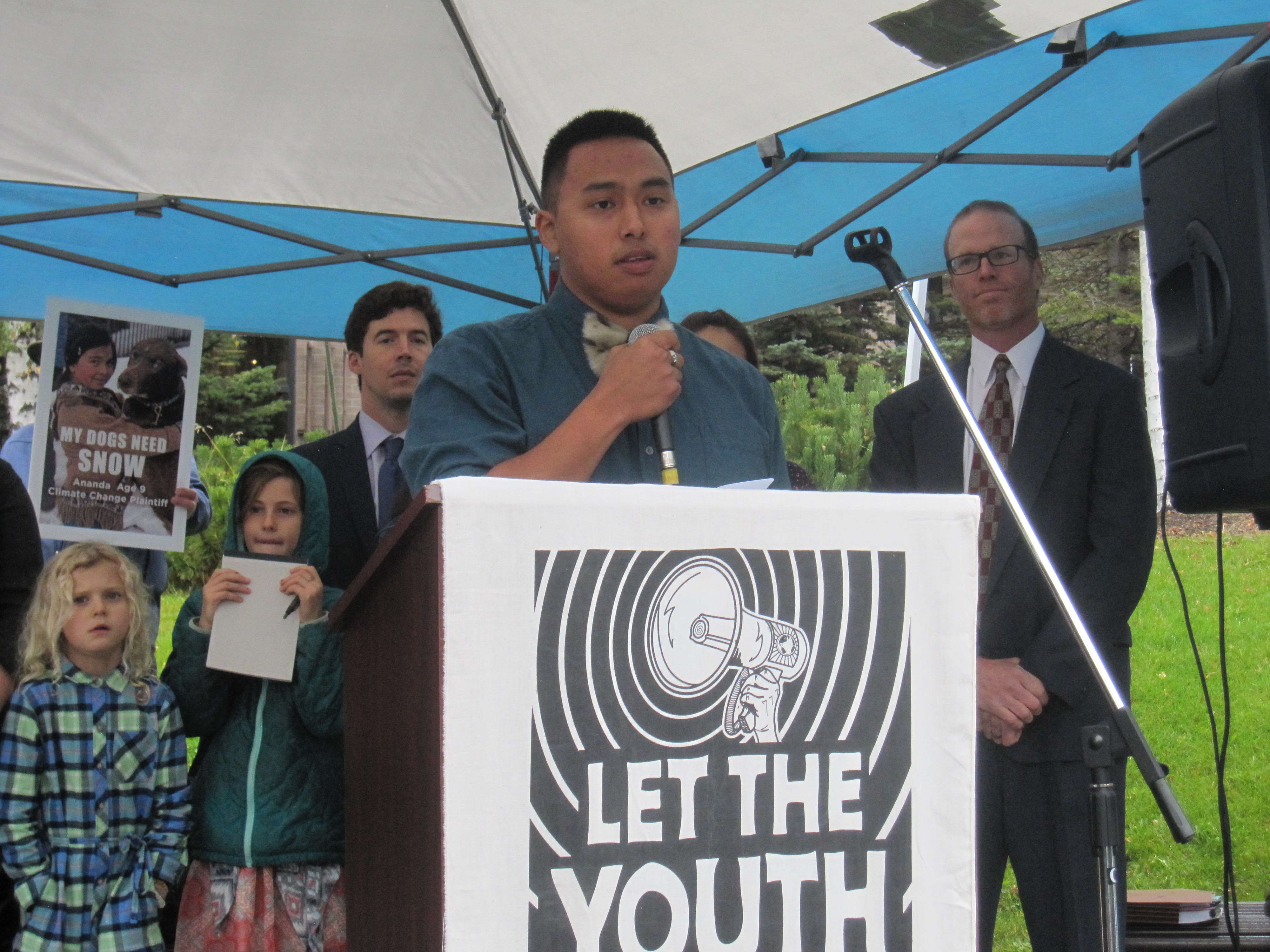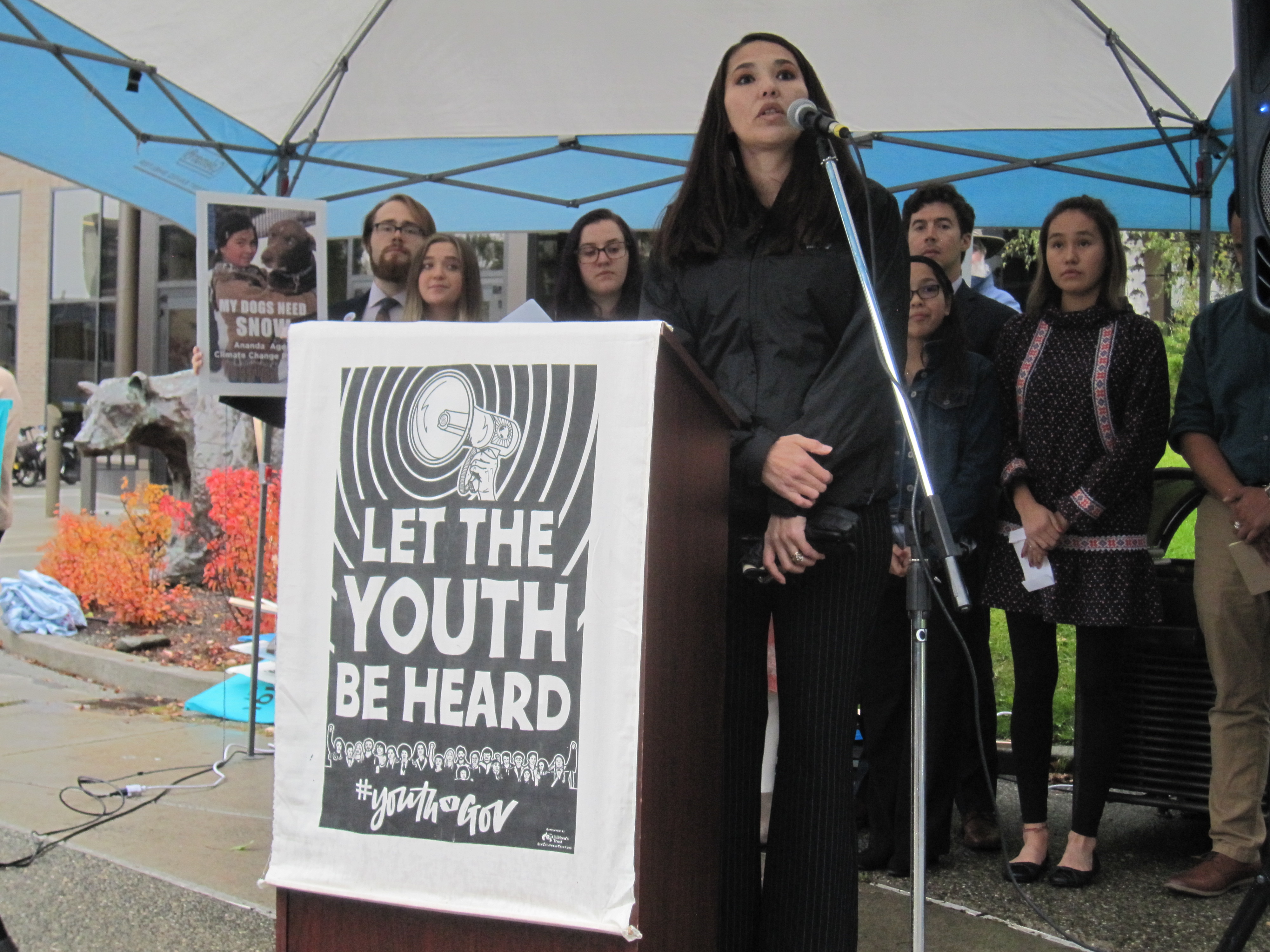An Alaska youth climate change lawsuit has reached the state’s top court
The state's top court is being asked to overturn a lower court's dismissal. If the plaintiffs succeed, they will be able to argue the case's merits in that court.

The Alaska Supreme Court will decide whether state policies as policies promoting oil development can be challenged as violations of young people’s constitutional right to be protected from climate change.
In an Oct. 9 hearing that attracted a standing-room-only audience, an attorney representing a group of young Alaskans argued that Alaska’s government, through its pro-oil policies, is exacerbating climate change that is occurring more rapidly in the Far North than elsewhere in the world. The arguments were the latest chapter in a 2017 lawsuit challenging the state’s climate-change policies.
“A decision can be made that any affirmative government action that contributes to climate change would violate the plaintiffs’ constitutional rights,” Andrew Welle, an attorney with Our Children’s Trust, an Oregon-based nonprofit that is managing the Alaska lawsuit and similar youth lawsuits filed elsewhere in the nation, told the justices.
[Alaska youths sue to force state action on climate change]
An attorney for the state, in response, argued that environmental protection in all its forms is already addressed by agency decision-making that also must consider a variety of competing interests, including economic development and job creation, power generation, public health, cultural protection and other services.
Impacts of climate change have to be weighed against all those interests, and the decisions weighing competing interests are up to non-judicial branches of government, said Assistant Attorney General Anna Jay.
“Ultimately, the issues raised by the appellants are issues that must be taken up by the political branches,” Jay told the justices.
The case is before the Alaska Supreme Court because a lower court judge last year dismissed the complaint as one that could not be addressed judicially.
In his Oct. 30, 2018 ruling, Superior Court Judge Gregory Miller said the issue was one for policy-makers to decide and that a court ruling would not have any real effect.
“A declaratory judgment would not impact greenhouse gas emissions in Alaska, protect Plaintiffs from the alleged injuries, or compel the state to take certain action.” The Sinnok complaint was similar to a 2011 complaint, Kanuk v. Alaska, that was ultimately dismissed by the state Supreme Court, and thus a similar dismissal was legally warranted, Miller ruled.
In their appeal to the Supreme Court, the youths’ attorneys have argued that the newer complaint has a legal basis that is substantially different from the earlier lawsuit.
While the Kanuk complaint faulted the state for lack of action addressing climate change, the Sinnok complaint faults the state for its affirmative pro-oil policies, making the lawsuit and the issues behind it appropriate for a judicial determination, Welle said.
He cited, in particular, the state’s energy policy, enacted into law in 2011, and a provision in it that calls for more development of oil, coal, natural gas and other nonrenewable energy.
“This is not a case in which the plaintiffs are challenging the state’s mere inaction or its mere failure to adopt policies to protection them from climate change,” he said. “Plaintiffs brought this case because the state has codified in statute in AS 44.99.115 2B and systemically implemented a state energy policy to promote fossil fuels, exacerbating climate change and affirmatively harming these young plaintiffs.”
Our Children’s Trust is representing youth in several climate cases around the nation. The best-known case, Juliana v. U.S., was filed in federal court in Oregon in 2015 and targets federal policies. That case remains active and was argued over the summer in the 9th Circuit Court of Appeals.

The Alaska case has some uniquely Arctic elements.
The plaintiffs, several of them Alaska Native, have special ties to the lands and waters of the Arctic or near-Arctic areas. Several are from cultures or families that depend on wild fish or game for food or on solid ice for safe rural travel, all of which are imperiled by rapidly warming temperatures, acidifying waters or both. Some of the plaintiffs have served in the past as Arctic Youth Ambassadors, participating in a program that was started by the Obama administration as part of the U.S. chairmanship of the Arctic Council.
The first named plaintiff in the case, Esau Sinnok, is one of those former Arctic Youth Ambassadors. Sinnok hails from the Inupiat village of Shishmaref, which is one of the severely eroding coastal villages that are planning a full relocation in response to climate impacts. Rapid erosion at Shishmaref and similarly situated Alaska villages is blamed on warming-related factors: the loss of sea ice that allows waves that crash ashore, plus the thaw of permafrost that previously helped keep shorelines intact.
“Climate change is not just a political issue for me. It’s my lifestyle. It’s what I face every day,” Sinnok, said at a news conference that followed the oral arguments. “The very thought of just losing your home because rising sea levels and storm surges and flooding is causing the island to erode, The one and only place that I get to call home is being eaten by the sea. It’s really stressful and really scary thought that my future generations of Shishmaref people will not be able to live on the island anymore.”
Another plaintiff, Griffin Plush of Seward, mentioned wildfire smoke — a big problem in the state during the fierce 2019 fire season — as a climate-change impact that hurts young Alaskans.
“For residents of Seward, for residents of Southcentral (Alaska), for residents of Anchorage, this past summer is something that is really scary,” Plush, another former Arctic Youth Ambassador, said at the news conference. “I could not breathe most days outside in the summer.”
The Supreme Court is not being asked, for now, to rule on the legal merits of the plaintiffs’ arguments. The court, for now, is to decide whether Miller’s dismissal should stand or be overturned, thus allowing the case to proceed to the point where the arguments can be heard in court.
Nonetheless, justices hearing the oral arguments asked questions that indicated they are receptive to the young plaintiffs’ case.
It may come down to a question of whether clean air and land a stable, life-sustaining climate are to be included in the fundamental rights guaranteed by the constitution, said Justice Susan Carney.
Doing so would be in line with precedent, Carney said. “Isn’t clarifying the scope of a right what we do all time?” she asked Jay.
The arguments about the plaintiffs’ rights to a clean environment and a stable climate might be seen as similar to the Supreme Court’s past rulings about Alaskans’ constitutional rights to privacy, said Justice Daniel Winfree.
On the other hand, the justices pointed out as they questioned the attorneys, the state constitution explicitly calls for Alaska resources to be used in a way that maximizes benefits to the citizens. That mandate could be used to call for more oil development, Winfree said.
“Can’t someone else come in and say, `I’ve got a constitutional right to a job?’” he asked Welle.